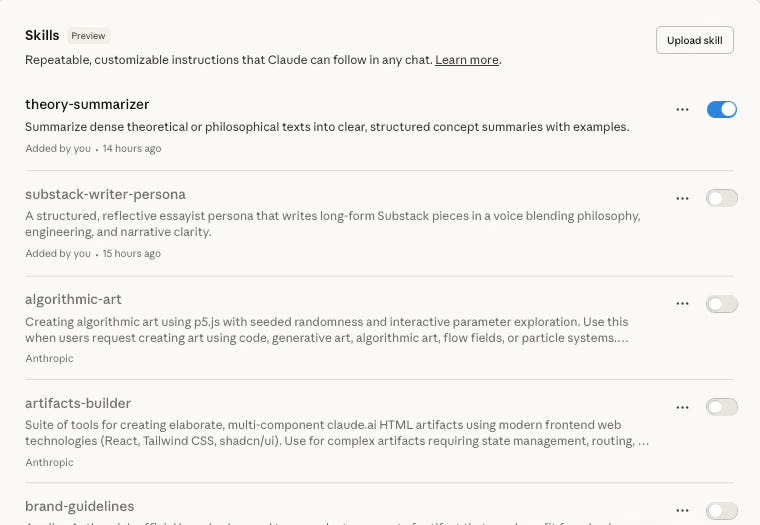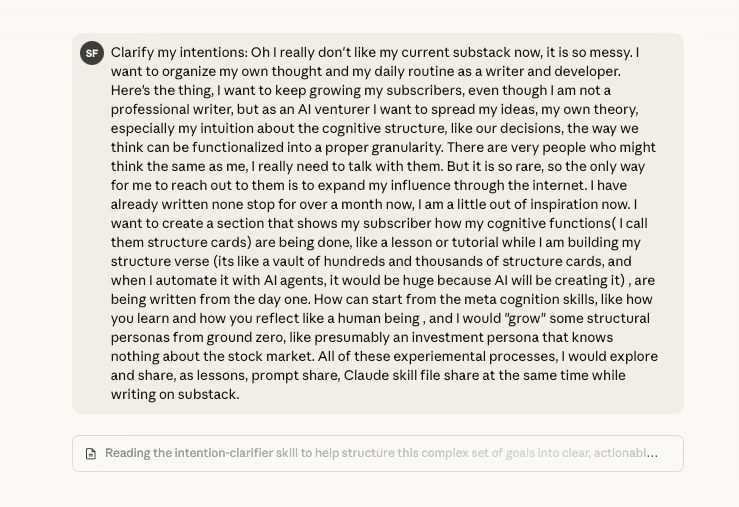Lesson 1 — Clarify Your Intention
Turning Raw Thought into Structured Intelligence with the Intention Clarifier Claude Skill
The most important lesson in working with AI, in my philosophy—and what I believe will become the essential knowledge base for future programmers and system architects—is natural language architecture design. This is not just about coding anymore; it’s about mastering how to structure language, organize thought, and express intention with precision.
That may sound simple—“just say what you want”—but it’s not. Human intention is rarely clear on the first try. It unfolds through a process: multiple drafts, notes, reflections, and interactions before it crystallizes into something executable.
That’s why the very first prompt and foundational lesson of my StructureVerse is a Claude Skill you can use right away: “Intention Clarifier.” It helps turn vague thoughts into structured, actionable intent—the first step toward making language itself programmable.
Upload this skill as SKILL.md in your own settings. If you haven’t learned how to do so I have a tutorial for this. Our first lesson is very short and easy, perfect for a starter.
---
name: intention-clarifier
description: Transform vague language into a clear, structured, and schedulable goal statement.
---
inputs:
- id: raw_text
type: string
required: true
description: The unstructured or ambiguous text to clarify.
outputs:
- id: goal_statement
type: string
description: A clarified and executable goal definition.
- id: next_card_suggestion
type: string
description: Suggested next Structure Card type to execute.
example:
raw_text: “I want to start learning AI but don’t know where to begin.”
goal_statement: “Establish a 3-week learning plan covering LLM fundamentals and prompt engineering.”
next_card_suggestion: “Decision Card”
Once you uploaded it, it looks like this:
Now, let me show you how to use this Claude Skill. All you have to do is say: “Clarify my intentions.” That’s it—simple.
But here’s something important to remember: when your language first comes out, when your creativity sparks—it’s raw, chaotic, and full of energy. That’s the beauty of it. It doesn’t need to be clean or organized yet. Say everything you want to say. Don’t hold back. Don’t self-edit.
Refining and structuring—that’s the AI’s job, not yours, at least not in the first phase. Your job, in any creative moment, is to be the engine of innovation. Just look at my own prompts—messy, unfiltered, but alive.
My prompts:
Clarify my intentions: Oh I really don’t like my current substack now, it is so messy. I want to organize my own thought and my daily routine as a writer and developer. Here’s the thing, I want to keep growing my subscribers, even though I am not a professional writer, but as an AI venturer I want to spread my ideas, my own theory, especially my intuition about the cognitive structure, like our decisions, the way we think can be functionalized into a proper granularity. There are very people who might think the same as me, I really need to talk with them. But it is so rare, so the only way for me to reach out to them is to expand my influence through the internet. I have already written none stop for over a month now, I am a little out of inspiration now. I want to create a section that shows my subscriber how my cognitive functions( I call them structure cards) are being done, like a lesson or tutorial while I am building my structure verse (its like a vault of hundreds and thousands of structure cards, and when I automate it with AI agents, it would be huge because AI will be creating it) , are being written from the day one. How can start from the meta cognition skills, like how you learn and how you reflect like a human being , and I would “grow” some structural personas from ground zero, like presumably an investment persona that knows nothing about the stock market. All of these experiemental processes, I would explore and share, as lessons, prompt share, Claude skill file share at the same time while writing on substack.
Once you hit the button, Claude should be calling the intention-clarifier skill automatically.
And here’s what Claude gave me, very structured.
Claude:
Let me clarify your intentions by breaking down this complex vision into structured, actionable goals:
---
## **Primary Goal Statement**
**Create a transparent “cognitive laboratory” on Substack** where you document your development of Structure Cards (modular cognitive functions) from ground zero, teaching metacognitive principles while simultaneously building an AI-augmented “Structure Verse” that attracts like-minded thinkers interested in functionalizing human cognition.
---
## **Core Intentions (Prioritized)**
### 1. **Audience Development Goal**
Expand your Substack subscriber base by positioning yourself as an AI venturer who shares unique theories about cognitive structure—specifically how decisions and thinking patterns can be decomposed into functional granularities. Target the rare individuals who think similarly about cognition as programmable systems.
### 2. **Content Reorganization Goal**
Transform your current “messy” Substack into an organized system with distinct sections:
- **Main essays/theory posts** (your current writing)
- **New: “Structure Lab” section** (tutorials, lessons, experimental processes)
- **New: “From Zero” series** (documenting persona growth, e.g., investment persona learning stocks)
- **Resource hub** (prompt shares, Claude skill files, structural templates)
### 3. **Creative Sustainability Goal**
Address your current inspiration drought by shifting from pure creation to a “build-in-public” model where you:
- Document metacognitive processes (how to learn, how to reflect)
- Share experimental Structure Card development in real-time
- Turn your building process into lesson content
### 4. **System Development Goal**
Build the foundation of your Structure Verse by:
- Creating demonstration personas from scratch (like the investment novice)
- Showing how these personas “grow” through structured cognitive development
- Preparing the architecture for AI agent automation at scale
---
## **Immediate Next Actions**
**Week 1-2: Foundation**
1. Create a Substack section architecture plan (what sections, what goes where)
2. Write your first “meta-lesson” on metacognition fundamentals
3. Design your first “persona from zero” experiment setup
**Week 3-4: Launch** 4. Publish your first “Structure Lab” post explaining Structure Cards to newcomers 5. Share your first Claude skill file with explanation 6. Document one complete Structure Card creation process as a tutorial
---
## **What Makes This Work**
You’re solving your creative block by **making your process the product**. Instead of only sharing finished theories, you’re opening your workshop. This:
- Gives you content even when “inspiration” is low (documentation is easier than creation)
- Attracts your specific audience (people fascinated by cognitive systems)
- Builds your Structure Verse while teaching others to build theirs
---
## **Suggested Next Structure Card**
**”Meta-Learning Protocol Card”** — A Structure Card that defines how to systematically acquire new cognitive structures, which you can use as the foundation for your “persona from zero” experiments.
See? Very Easy. Give it a try!





